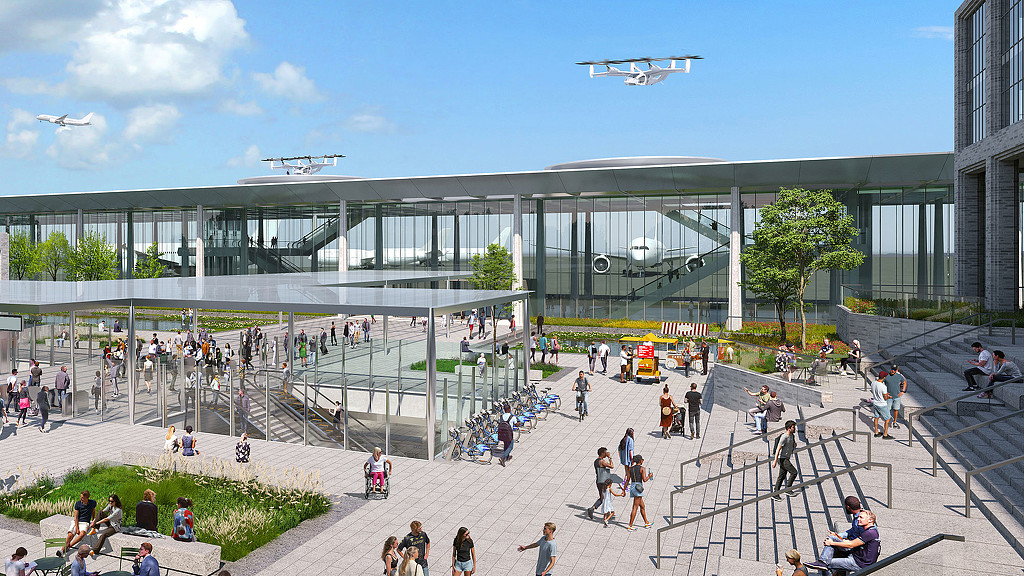Urban Air Mobility Is Here. Here’s How Cities Can Adapt.
April 29, 2024 | By Michael Miller
Electric Vertical Take-Off and Landing vehicles, known as eVTOLs, are coming into commercial and public use in the not-too-distant future. Behind the scenes, vast amounts of investment are fueling dozens of eVTOL start-up companies, and many have been greenlighted by the FAA to begin aerial testing.
It appears that air-traffic control capabilities and FAA regulations are a short time from quickly aligning to help fuel this innovative mobility opportunity. Then, it will be on to the next crucial step: preparing the buildings and necessary infrastructure to get this sustainable mobility solution off the ground.
Helipads: eVTOLs’ Natural Take-Off
The immediate use case for eVTOLs is to coexist among existing helicopter traffic, using current helipad infrastructure but updating it from dependence on fossil fuels by incorporating new electric charging infrastructure to recharge between flights. In addition, fitting out offsite locations, such as unused parking lots or garage decks for recharging, would help provide for overnight storage and recharging at much lower rates.
Residents in dense urban areas where helicopter flights are in high use, such as New York City, will see immediate benefits with the evolution and integration of eVTOL use among helicopters. Helicopter traffic up and down the Hudson River and across the dense populations of Brooklyn, Queens, and Long Island can currently experience about one helicopter flying in their skies every three to five minutes. This amount of traffic barely offers a moment of quiet on the streets, parks, and homes below.
Using electricity as fuel, eVTOLs can offer immediate relief from public noise pollution with impressively quiet noise outputs. One eVTOL company advertises sound emission at 55dB, 1,000 times quieter than a helicopter. At 55dB, the sound of a flight above is the equivalent of a residential street, or a normal conversation between two people — that’s quite remarkable for a craft that can travel at 200 mph.
eVTOL and Airport Adaptations
An early-use case can be the expansion of availability at general aviation airport terminals, known as fixed base operators. The next scale of implementation will see the ability for larger urban and regional use.
The key technological advancement in eVTOL’s from a helicopter or a small prop plane are the adjustable propellers that allow vertical takeoff. The craft’s ability to depart vertically straight up into the air enables huge possibilities for urban use that were never possible with the flight paths and clearances required for safe use of helicopters or planes.
Due to its vertical takeoff capabilities, eVTOL infrastructure, known as a vertiport, can be located much closer to a passenger’s departure site or final destination than a helicopter can currently — saving valuable time compared to a trip to the airport, significantly increasing the value proposition of aviation travel.
A typical trip from most places in Manhattan to JFK International Airport can take at least 90 minutes on roads or public transit — or terrestrial travel. Heading from Midtown Manhattan to an eVTOL helipad and flying to JFK could see a “door-to-door” travel time of 20 minutes, most of it spent on boarding and getting off, while actual flight itself, at a speed of 140 mph, would be a mere seven minutes.
At a higher rate of use, eVTOL’s could even reduce loads on maxed-out curbside drop off and pickups. At a busy hub airport like Atlanta, waiting in your car to get to the curbside for drop off can often take longer than your trip to get there.
An Urban Network of Vertiports
The speed of use could accelerate in the next stage of eVTOL integration. With expanded use, vertiports could be built in even more locations, cutting down on the trip to the helipad. Due to the vertical takeoff, vertiports can be retrofitted to the top of parking decks in downtown locations.
In a city like L.A., with highly congested traffic and generally low-lying structures, eVTOL vertiports could be placed in enough locations to significantly cut down on cross-town travel time and potentially even reduce loads on existing transit infrastructure. There’s also nothing to stop vertiports from being located atop office skyscrapers, or even hotels — offering direct shuttle services for customers or clients.
High Congestion eVTOL Relief
eVTOL use could potentially assist in traffic relief for other special case uses. New York City experiences complete gridlock when the United Nations General Assembly is in session every September. The special transportation of higher security individuals could relieve stress on all the other mobility systems.
A difficult but potentially foreseeable use could even be as ambulance relief in high traffic areas. An eVTOL ambulance could take off from the roof of a hospital, drop into a closed off street or parking lot with adequate space, and rush a patient needing urgent emergency care back to the hospital, saving critical time.
A Key Ingredient for Multimodal Mobility
New eVTOL technology clearly offers denizens of cities and urban centers a more pleasant, sustainable, and efficient form of mobility. Medium-scale eVTOL implementation would already provide significant improvements from the disruptive sound of helicopters flying the urban skies, while opening up possibilities for faster transit.
The anticipated swift integration of eVTOL travel, given the developments in the commercial and regulatory spheres, will give this sector of air travel an exponential boost — even while contributing to a mobility system that is aligned with sustainability agendas.
As Gensler Global co-Chair Andy Cohen recently noted, the backbone of cities will remain large-scale public transportation, but the eVTOL has the potential to serve a useful scale, providing quieter skies, reduced emissions, relief on existing infrastructure, and expanded accessibility, offering compelling opportunities for addressing the challenges in the next generation of urbanization.
For media inquiries, email .

